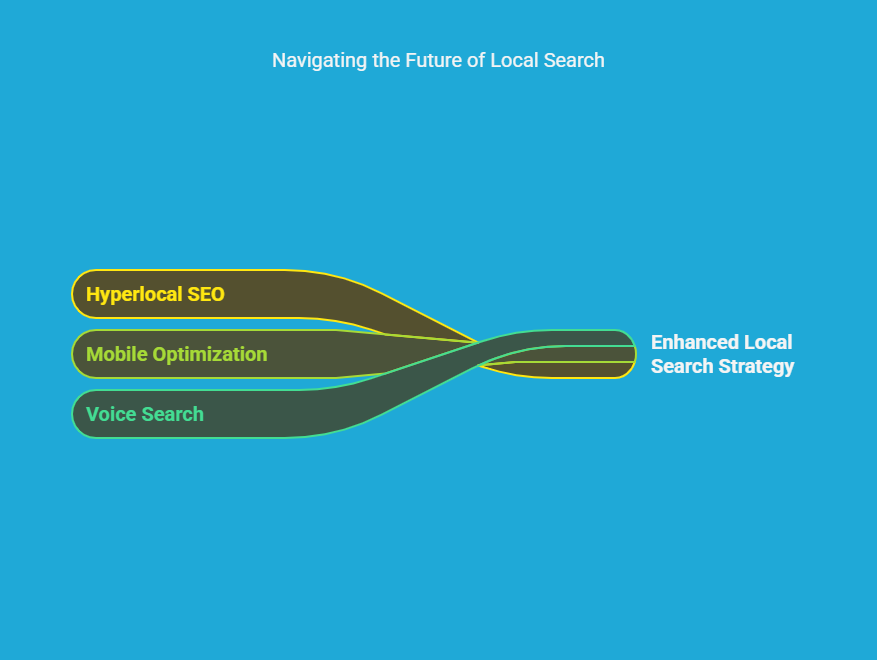I hope you enjoy reading this blog post.
If you want to get more traffic, Contact Us

Click Here - Free 30-Minute Strategy Session
Be quick! FREE spots are almost gone for this Month. Free Quote

The sphere of local search has undergone significant transformations, shaped by advancements in technology, evolving user behaviours, and the growing reliance on mobile devices. Businesses are increasingly tailoring their strategies to meet the demands of modern consumers, who value swift, accurate, and proximity-based information. Voice search, powered by AI, adds another layer of complexity, enabling conversational queries and nuanced interactions.
Key factors influencing this shift include the rise of hyperlocal targeting, where businesses focus on precise geographic areas, and the emphasis on mobile optimisation. These developments push brands to think beyond traditional methods, embracing dynamic techniques to enhance user experiences and capture local audiences effectively.

Click Here – Free 30-Minute Strategy Session
Be quick! FREE spots are almost gone for this Month
Voice search is reshaping the way people access information, particularly for local queries. With devices like Amazon Alexa and Google Assistant, users often search by asking questions conversationally. This shift has led businesses to optimise for natural language phrases and long-tail keywords.
Businesses must adapt to this revolution, ensuring their websites are optimised for conversational queries and hyperlocal intent.
Mobile behaviour is revolutionising how users engage with local search, driven by the ubiquity of smartphones. Studies show that over 60% of mobile users perform local searches to find nearby businesses, products, or services. Features like GPS integration and map applications enhance the immediacy of results, making proximity a key factor.
Emerging patterns reveal that users increasingly rely on “near me” queries driven by urgency and convenience. Mobile search results now prioritise speed, accuracy, and relevance, heavily influenced by user reviews and ratings. Businesses with mobile-friendly websites and quick-loading pages gain a competitive edge, while poorly optimised sites risk being sidelined.
Hyperlocal SEO refers to optimising online visibility for businesses targeting customers in a specific geographic area. It zooms in on micro-locations, such as neighbourhoods, streets, or even a block, rather than focusing on a broader city or region. This strategy is particularly essential for small, brick-and-mortar businesses.
Core elements of hyperlocal SEO include:
Hyperlocal queries often include phrases like “near me” or specific landmarks. Factors such as accurate geotagging and mobile responsiveness heavily influence ranking for hyperlocal searches.
Mobile-first indexing plays a critical role in improving local SEO by prioritising websites optimised for mobile devices. Search engines, such as Google, primarily use the mobile version of a site for ranking and indexing. For local businesses, this means having a responsive design is essential to better visibility.
Key elements include ensuring fast page loading speeds, mobile-friendly navigation, and optimised local content. Features like clickable phone numbers and maps enhance usability for mobile users.
Local citations and consistent NAP (Name, Address, Phone number) details further bolster rankings. Businesses must audit their websites to align with these best practices for local SEO success.
Geo-targeting plays a pivotal role in reaching hyperlocal audiences by enabling businesses to tailor their content, ads, and services to specific geographic locations. Tools like Google Ads and Facebook Ads allow companies to define specific areas, from broad regions down to precise neighbourhoods. This ensures marketing efforts are more relevant and impactful.
Effective geo-targeting relies on a combination of factors:
Geo-targeting aligns advertising with the immediate needs of local users.
Structured data plays a significant role in improving local search visibility by enabling search engines to better understand a business’s offerings. Through structured data markup, businesses can communicate key details such as address, opening hours, services, and reviews directly to search engines.
LocalBusiness make business information more accessible.By adhering to schema.org guidelines, businesses ensure consistent, accurate information delivery, strengthening their position in local search results.
Online reviews and ratings significantly impact local SEO performance, playing a crucial role in shaping both user trust and search engine rankings. Search engines like Google consider customer reviews a ranking factor, reflecting a business’s credibility and relevance. Positive and frequent reviews increase visibility in local search results, attracting more customers.
Key factors include:
Consumers increasingly rely on reviews when making purchasing decisions, making their optimisation indispensable.
Artificial intelligence (AI) and predictive analytics are revolutionising how businesses and users interact with local search. AI-driven algorithms analyse vast amounts of data to personalise search results, ensuring users receive the most relevant local suggestions based on their needs and preferences. Predictive analytics leverages user behaviour patterns, search history, and location data to anticipate queries even before they are fully typed.
Key developments influenced by these technologies include:
These innovations enable more dynamic and accurate local search capabilities.
Local search optimisation for ‘near me’ queries has become vital as users increasingly seek instant, location-specific results. Businesses must focus on precise NAP (Name, Address, Phone) consistency across platforms. Creating and optimising Google Business Profiles is essential, including adding accurate location details, business hours, and high-quality images to enhance user trust.
Geo-specific keywords should be strategically incorporated into content, metadata, and schema markup to signal relevance. Positive online reviews and ratings also improve rankings for local searches. Mobile-friendly websites with fast loading speeds are crucial for accommodating searchers on the move. Combining these strategies ensures visibility for hyperlocal audiences.
Social signals, which include likes, shares, comments, and reviews on social media platforms, serve as a powerful indicator of brand credibility and engagement. These interactions influence hyperlocal SEO by driving traffic, increasing visibility, and enhancing trust among local audiences. Search engines consider social signals as part of a broader algorithm to gauge the relevance of a business in specific local markets.
Businesses with active social media profiles showcasing local content, events, or partnerships benefit from increased community interaction. Encouraging user-generated content, such as posts tagging the business, also amplifies visibility. Links shared across social platforms indirectly improve local rankings by boosting website authority.
Augmented Reality (AR) and Virtual Reality (VR) are reshaping hyperlocal search by enhancing user engagement and merging digital content with real-world environments. These technologies allow users to visualise businesses, products, and services in their physical context. For instance:
As AR devices evolve, businesses will increasingly integrate hyperlocal SEO strategies, tagging locations and ensuring compatibility with AR maps and applications, driving hyper-personalised search experiences.
Several businesses have effectively leveraged voice, mobile, and hyperlocal SEO to dominate their local markets.
Local search is set to evolve significantly, driven by advancements in technology and changing user behaviour. Voice search adoption will likely grow as smart assistants become more accurate and intuitive. Mobile devices will continue to dominate, shifting the focus towards mobile-first SEO strategies and creating seamless local search experiences. Hyperlocal targeting, aided by AI and geolocation technology, is expected to become more precise, enabling businesses to deliver tailored results for increasingly specific queries.
Businesses must stay adaptable, tracking emerging search trends closely and refining their strategies in line with shifting algorithms and user preferences, ensuring relevance in the competitive local landscape.

LEAVE A REPLY